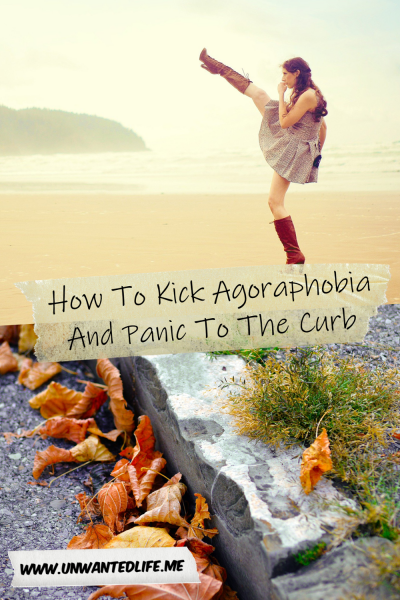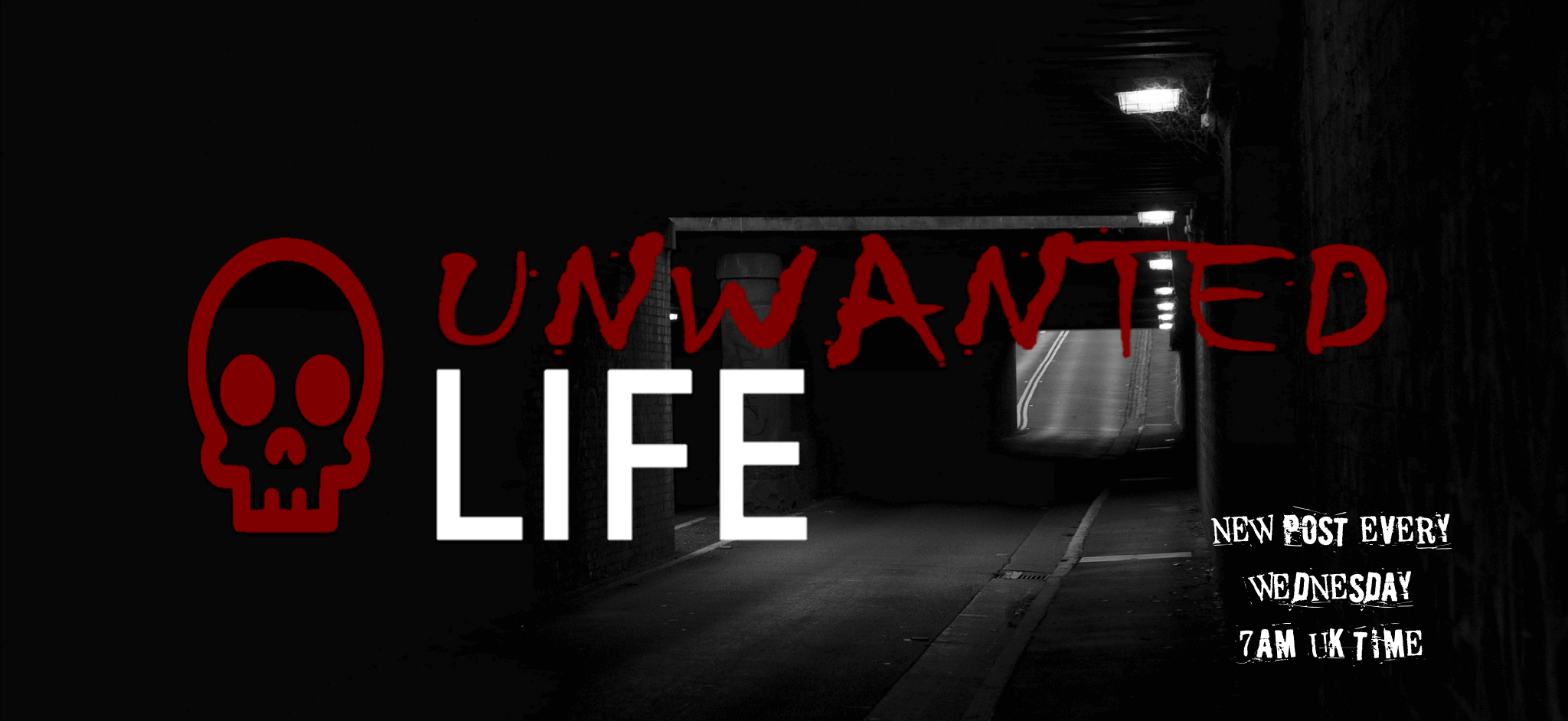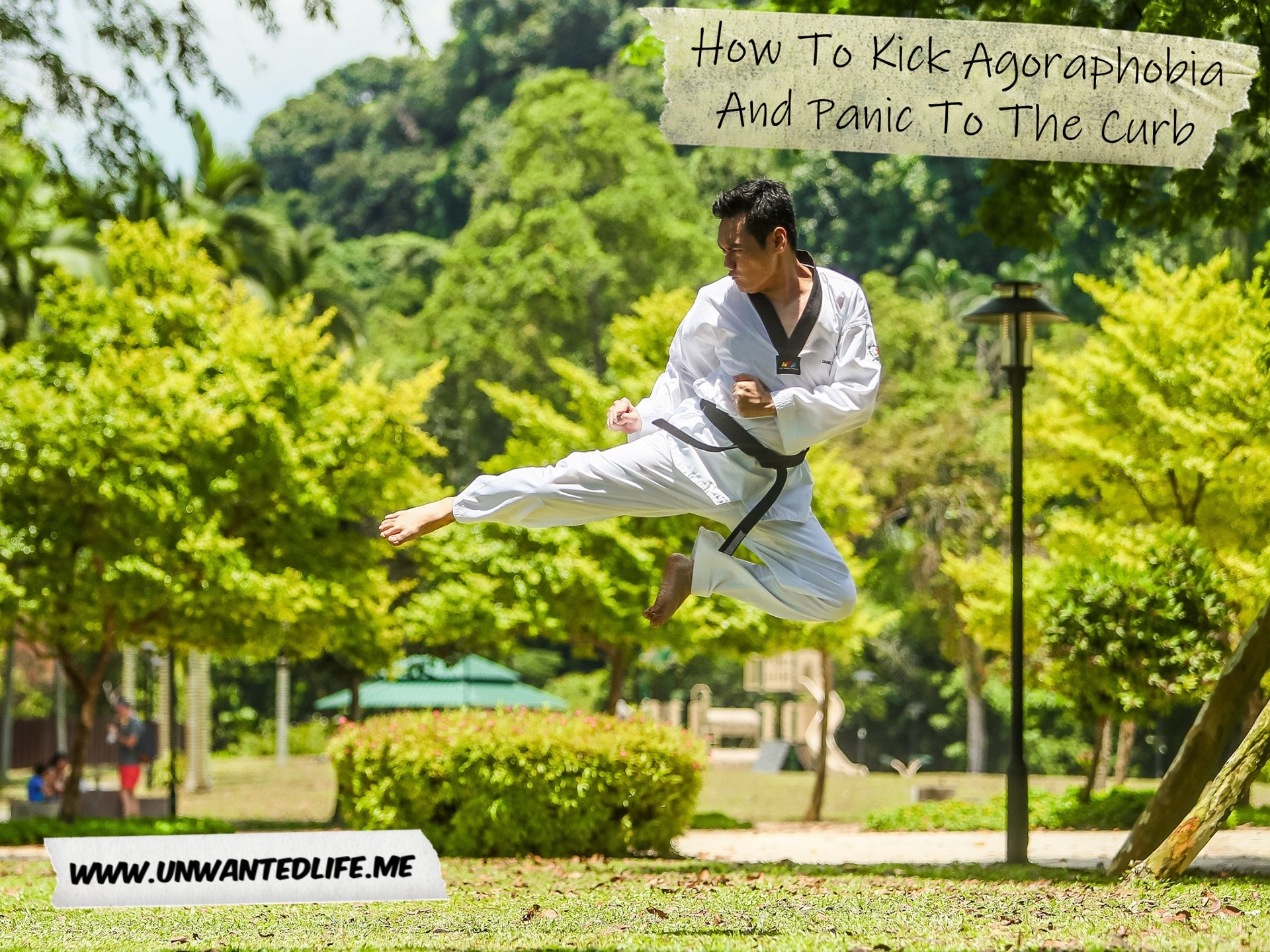Quite a while ago now, I wrote an article about the Fear Of Going Somewhere New, making this article a very long overdue follow-up. It also works as a follow-up to my other article, Out Of My Comfort Zone: Christmas Edition, as well. I you’ve read either of those, then you’ll know about my agoraphobia. Thus, I hope you find this article on how to overcome agoraphobia useful.
What Is Agoraphobia
We’ve all seen the extreme version of agoraphobia in movies and TV shows, such as the film Kimi starring Zoë Kravitz. While this form of agoraphobia does exist, it’s not the most common version, and therein lies the problem. We’ve been conditioned to see this extreme version of agoraphobia as being the only version of agoraphobia. Which is why I was surprised when I first got diagnosed with it.
In its simplest definition, someone with agoraphobia is afraid to leave an environment they consider safe (Better Health Channel). This could be your home (in the extreme version) but also your neighbourhood or even your town. For this to be classified as agoraphobia, like many psychological conditions, it has to have been happening for at least six months.
Agoraphobia is a type of anxiety disorder. A person with agoraphobia is afraid to leave environments they know or consider to be safe. In severe cases, a person with agoraphobia considers their home to be the only safe environment. They may avoid leaving their home for days, months, or even years.
The DSM-IV (Diagnostic and Statistical Manual of Mental Disorders, Fourth Edition) defined agoraphobia as avoidance or endurance of dread causing situations where escape would be difficult or impossible in the event of a panic attack or developing symptoms that would cause embarrassment (Craske and Simos, 2013). It can occur in situations like public transport or crowded spaces.
This is how my agoraphobia manifests, in a fear of causing myself embarrassment due to losing bladder and bowel control, caused by the sensations I had when I had my first major psychotic break.
However, the current psychological definition of agoraphobia, as laid out in the DSM-V (Diagnostic and Statistical Manual of Mental Disorders, Fifth Edition), requires fear or anxiety of at least two or more of the following, according to Substance Abuse and Mental Health Services Administration (2016):
- Using public transport.
- Being in open spaces.
- Being in enclosed spaces (e.g., tunnel or shop).
- Standing in line or being in a crowd.
- Being outside the home alone.
Both DSM-IV and the DSM-V talk about situations being avoided, so that’s all you really need to focus on for a basic understanding of agoraphobia. A fear or anxiety that causes someone to avoid certain situations and environments.
What Is A Panic Attack
A panic attack is where someone experiences an intense level of fear or discomfort that reaches a peak within minutes, where they experience four or more of the following symptoms (Substance Abuse and Mental Health Services Administration (2016):
- Palpitations, pounding heart, or accelerated heart rate.
- Sweating.
- Trembling or shaking.
- Sensations of shortness of breath or smothering.
- Feeling of choking.
- Chest pain or discomfort.
- Nausea or abdominal distress.
- Feeling dizzy, unsteady, lightheaded, or faint.
- Derealization (feelings of unreality) or depersonalisation (being detached from oneself).
- Fear of losing control or “going crazy”.
- Fear of dying.
- Paresthesias (numbness or tingling sensation).
- Chills or heat sensations.
There is a pretty long and controversial history between panic attacks, panic disorder, and agoraphobia (Wittchen et al., 2008). Until the DSM-V was published in 2013, agoraphobia and panic disorder were essentially the same disorder (Asmundson, Taylor, and Smits, 2014). However, even before they were separated into two distinct disorders, there were some people questioning why they were considered to be the same condition.
Wittchen et al. (2008) study found that agoraphobia exists as a clinically significant phobic condition which was independent of panic disorder. Their study used data from 3,031 people from a government registry in the greater metropolitan Munich. They found that the majority of the agoraphobic subjects never experienced a panic disorder. This challenged the current understanding of agoraphobia, which was that it was a consequence of panic.
The introduction of the DSM-V saw the separation of panic disorder and agoraphobia, introducing separate diagnoses and introducing new criteria and guidelines.
The new diagnosis for a panic disorder, according to Asmundson, Taylor, and Smits (2014), is that it is a recurrent yet unexpected series of panic attacks. Whereby there must be at least one month of persistent fear after at least one panic attack. This can manifest as worry about the consequences of further panic attacks, fear of having more panic attacks or using maladaptive behaviours related to the attacks. (e.g. avoidance).
The key to what makes this a panic disorder rather than something else is if it can be better explained by another diagnosis. Such as panic attacks caused by social anxiety disorder where they’re only triggered by social situations or agoraphobia (Asmundson, Taylor, and Smits, 2014). Which is how my social anxiety disorder and agoraphobia work. They can cause panic attacks, which, at their worst, could happen several times a day. Although they started in the 00s, since 2013 would no longer be considered a panic disorder.
Although agoraphobia might not be an extension of panic disorder anymore, that doesn’t mean you can’t experience panic attacks because of your agoraphobia. It also doesn’t mean that what works in treating one won’t work for the other.
And this is where it can get messy. For example, a big part of my anxiety disorders is my bodily sensations, which, if left unchecked, can cause a psychotic episode. These bodily sensations become warning signs for a potential panic attack, and thus they cause fear and anxiety. This made me, and makes others like me, hypervigilant about those bodily sensations. This is why mindfulness can be a trigger for me as a lot of it focuses on paying attention to your bodily sensations.
Unfortunately, these cause a feedback loop. Feeling anxiety about such bodily sensations causes you to pay more and more attention to them (Craske and Simos, 2013). This increases your likelihood of experiencing greater anxiety, or worse, a panic attack. And in my case, a psychotic episode.
So, you can experience the above bodily sensations and hypervigilance caused by having a panic attack, but what makes it a panic disorder or something else like agoraphobia comes down to the diagnostic criteria. The most important one being, can these panic attacks be better understood by another anxiety disorder.
Therefore, although panic disorder and agoraphobia are two distinct disorders, they remain linked because of their overlapping symptoms (Asmundson, Taylor, and Smits, 2014).
Short-term Fixes For Agoraphobia And Panic
Be prepared
Feeling anxiety about something that likely isn’t going to happen sucks. I know this from personal experience. But with most fears, they can be better managed. So much like a boy scout, always be prepared.
For example, my anxiety disorders affect me in a very specific way that makes me fear losing bladder and bowel control, even though this has never happened to me. One way to prepare for this when going to new places is to become aware of where the toilets might be.
Another example could be, if you’re worried about going somewhere new, then work out how to get there and back in advance using Google Maps.
Use Distractions
Distractions can be handy. I’ve used them to manage a lot of my mental health issues. I sleep with my TV on (set with a timer to turn itself off) because it stops my mind from going to dark places when I try to sleep when it’s quiet. I also do something similar with headphones and music. I use my headphones and music to block out one of my anxiety disorder triggers, which is hearing people whisper or laugh. There are lots of distractions that can be used. It’s just a matter of tailoring your distractions to your needs.
Go with someone
One of the most obvious solutions to agoraphobia and panic attacks is to go out with people you trust. Their presence can put you at ease. This role can also be taken up by pets, which is why you often hear about Americans with support animals. I used to rely on my partner coming to my many hospital appointments for this very reason.

Long-term Solutions For Agoraphobia And Panic
Talk to a professional
Talking to a professional is always a good place to start. Talk to your GP about your struggles and they should be able to refer you to an appropriate service. You can also contact mental health services like Mind which offer local mental health support through group therapy and one-to-one therapy, although that can vary by area. You might also want to check out my Global and UK crisis and mental health information pages, which you can find here (Global) and here (UK).
Accept Your Symptoms
One of the big steps towards improving the quality of life regarding agoraphobia and panic attacks is to accept the symptoms. I know this isn’t something you want to hear, but it’s something you need to hear. You can learn to live with agoraphobia and panic attacks. You may even get to a point where they feel like they’ll never be a problem again.
However, they may likely always be with you. I know mine are, even though I’ve gone from having several anxiety-induced psychotic episodes a day to going without one for a year or more at a time. The triggers are still there and they can still be activated. But I’ve accepted that, and I know they’re still there. But knowing that makes it easier to manage them. I can experience them being triggered without freaking out about it, and that’s an important ability to have.
Graded exposure
The biggest change I ever made to handling my social anxiety disorder, my agoraphobia, and the panic attacks and psychotic episodes they can cause was a result of graded exposure. Also known as exposure therapy.
Graded exposure can be hard to use, because it means tackling your fears and panic head-on. But the long-term benefits can be truly amazing. However, it does require you to learn to let go of your short-term fixes and other safety behaviours to get the best recovery outcomes.
Simply put, with graded exposure you create a list of your fears and anxieties and order them from worst to least bad. You then create steps to work through those fears, from the least bad to the worst. A simple example of agoraphobia could be that if your least bad fear was going to the shop, then you’d create steps like going to the shop but not going in, and you’d keep doing that until you felt comfortable doing it. Then the next step could be to go into the shop with someone you know for one minute until you feel comfortable, and so on and so on.
People will use safety behaviours to avoid panic and other fear consequences, such as travelling with someone that makes them feel safe. However, these safety behaviours are also panic and anxiety-maintaining behaviours (Craske and Simos, 2013). Such behaviours reinforce panic and anxiety, making them more likely to happen in the future. This was why I had to stop using mine so I could improve my recovery outcomes, and it worked a treat.
To find out more about graded exposure and to download a free graded exposure workbook, click here.
Interoceptive exposure
If you’re not quite ready for graded exposure, then you could try starting with interoceptive exposure. This form of exposure therapy is where you use your imagination to help overcome your fears and anxieties. Using the example I just used in graded exposure, instead of going to the shop to help you overcome your agoraphobia, you’d imagine yourself going there instead.
If you’d like to learn more about interoceptive exposure, then click here.
Summary
Short-term fixes for agoraphobia have their uses, but if you want real change, you need to work through long-term solutions. The problem with this is that short-term fixes help us cope in the here and now, whereas the long-term solutions for agoraphobia are about delayed rewards. The rewards being better management of your agoraphobia or even extinction of it.
It’s a tough call to make because it’s hard to focus on what’s ahead when the present is so difficult. But if you can look at the bigger picture, the payoff can be life-changing. They were for me, and that’s why I created a graded exposure book, free for anyone to use so they can experience the same improvements in their quality of life that I did.
There are many applications for using interoceptive exposure and graded exposure. Such as a fear of flying. They’re pretty much ideal to be used to tackle anything that might cause you fear or anxiety. You’ve got nothing to lose by checking them both out.
As always, leave your feedback in the comments section below. Also, please share your experiences with agoraphobia and overcoming it in the comments section below as well. Don’t forget, if you want to stay up-to-date with my blog, then sign up for my newsletter below. Alternatively, get push notifications for new articles by clicking the red bell icon in the bottom right corner.
Lastly, if you’d like to support my blog, you can make a donation of any size below. Until next time, Unwanted Life readers.
References
Asmundson, G. J., Taylor, S., & Smits, J. A. (2014). Panic disorder and agoraphobia: An overview and commentary on DSM‐5 changes. Depression and Anxiety, 31(6), 480-486. Retrieved from https://onlinelibrary.wiley.com/doi/abs/10.1002/da.22277 and https://doi.org/10.1002/da.22277.
Craske, M. G., & Simos, G. (2013). Panic disorder and agoraphobia. In Gregoris Simos and Stefan G. Hofmann (Eds.), CBT for Anxiety Disorders: A Practitioner Book, First Edition (pp. 3-24). John Wiley & Sons, Ltd. Retrieved from https://www.academia.edu/68746810/Panic_Disorder_and_Agoraphobia_Michelle.
Substance Abuse and Mental Health Services Administration. (2016). Impact of the DSM-IV to DSM-5 Changes on the National Survey on Drug Use and Health. Substance Abuse and Mental Health Services Administration (US). Retrieved from https://www.ncbi.nlm.nih.gov/books/NBK519704/table/ch3.t10.
Wittchen, H. U., Nocon, A., Beesdo, K., Pine, D. S., Höfler, M., Lieb, R., & Gloster, A. T. (2008). Agoraphobia and panic. Psychotherapy and Psychosomatics, 77(3), 147-157. Retrieved from https://edoc.unibas.ch/8334/1/document%28164%29.pdf and https://www.karger.com/Article/Abstract/116608.


Thanks again for another informative article. My father suffered from agoraphobia years ago. In those pre-internet days, we understood very little about mental illnesses. I wish we had known more. Your blog provides a valuable window into these things.
Even with the internet in the 90s, it was still hard to get that information as access to the internet was hard and not many people had that privilege
What you mean long term? There is no cure for this? It’s my first time to know about this. And I agree talking to pro will help a lot.
When it comes to mental health, it’s not really about curing but improving someone’s quality of life. It’s not like having an infection that can be cured with a round of antibiotics. Some people might recover fully what they lost while others might not
As someone who suffers with agoraphobia, I found this post very informative and enlightening. I find what helps me the most is having someone with me and also rewarding myself with something whenever I manage to leave the home.
Thanks for sharing
Love the breakdown of this post. Understanding and preparation are amazing tools to living with different conditions. Your posts that I’ve come across are great aids to the conditions you cover. Thanks for sharing!
Thanks for commenting
Another honest and informative article. Great job explaining this sounds like the fight-flight or freeze response is so intense. Thank you for sharing some helpful tips for people to use when this happens..
Thanks for commenting
This is interesting as I have never known about someone I know being agoraphobic. Good suggestions for dealing with this.
Thanks for commenting
Another great post! I appreciate the background information and then the short-term (coping mechanisms) and long-term fixes (healing). Thank you for sharing to bring the reality of mental health to the spotlight. 💜
Thanks for commenting
What you mean long term? There is no cure for this? It’s my first time to know about this. And I agree talking to pro will help a lot